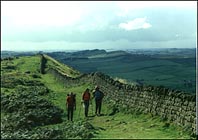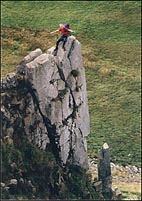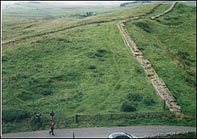Helen Rose: Hillwalking Diary January 2003.
Hadrian's Wall

Hadrian's Wall stretches coast to coast in the narrowest part of Northern England; from Wallsend on the River Tyne in the east, to Bowness-on- Solway in the west. The distance is 120 kilometres (seventy three miles), or eighty Roman miles. It is named after the emperor, who ordered its construction in 122AD. Originally, it was three metres (nine feet) wide and up to six metres (twenty feet) high. At every Roman Mile along its length there is a milecastle, which was used as a guard post, with turrets at every third of a mile serving as lookout posts. The wall was the North Western frontier of the Roman Empire until the final withdrawal of the legions from Britain in 410AD. History lesson over! Now for the fun of walking on a stretch of the wall.
 If you wish more information on the Wall, visit www.hadrians-wall.org where you will find details of all the adjacent areas of interest and transport arrangements.
If you wish more information on the Wall, visit www.hadrians-wall.org where you will find details of all the adjacent areas of interest and transport arrangements.
In the Autumn, the Glasgow Ramblers arranged a bus trip to Hadrian's Wall with a selection of linear walks on offer. They had a similar trip last year to the more westerly section and this trip was to take in the middle section of interest. I had not been on the previous trip but was assured the section we were going to walk, from Greenhead to Housesteads, was more interesting. Those who chose the easier walk were also able to visit Vindolanda where the museum has a reconstructed Roman House. As I had previously visited Vindolanda, I opted to go on the longer walk.
 Along the length of the wall there is a ditch or 'vallum' to the south and a whole series of forts, settlements and supply routes. The wall is a World Heritage Site and the land to the North is Northumberland National Park stretching to the Cheviot Hills, which I had crossed on the St Cuthbert's Way Walk mentioned in a previous article. The Pennine Way also crosses the wall.
Along the length of the wall there is a ditch or 'vallum' to the south and a whole series of forts, settlements and supply routes. The wall is a World Heritage Site and the land to the North is Northumberland National Park stretching to the Cheviot Hills, which I had crossed on the St Cuthbert's Way Walk mentioned in a previous article. The Pennine Way also crosses the wall.
We started at Greenhead Fort where there is a small museum and, very importantly, a tea shop so after the bus journey, fortified by the tea and scones, we set out on the walk. We stopped along the route to see the milecastles and the turrets which are remarkably well preserved considering their age. The weather held out although there were black clouds to either side of us with the sun beaming down in the middle onto the wall. The path runs alongside the wall - some people climbed onto the wall briefly for photos but this is discouraged to prevent further erosion.
The Romans generally built walls and roads in a straight line rather then contouring around hills so walking the path alongside the wall has many ups and downs. Although we only walked about nine miles, the elevation meant we were climbing about 3,000 feet in total, which is almost like climbing a Munro, so it is fairly hard work. The public bus stops at many of the sites on route so shorter walks are possible. However, we were committed to completing the planned section as the bus was picking us up at Housesteads Fort.
The surrounding countryside is very green and fairly flat which is unlike much of our scenery in Scotland where it is more mountainous. It was a pleasant change of scenery and reminded me of Southern Ireland . There was an interesting section at Crag Lough where high cliffs overlook the lake. From there on the path passes on top of steep crags to Vercovicium Roman Fort at Housesteads where there is a museum. Unfortunately we arrived after 5pm when the Museum was closed.
It was a fascinating walk and I would like to go back and walk other sections of the wall as it is such an important area of British History in a magnificent landscape. We still have part of the Antonine Wall in the outer westend of Glasgow but it was abandoned in 162AD leaving Hadrian's wall as the Northern outpost. Incidentally, you may be interested to know we have many Roman ruins in Scotland and Pontius Pilate is reputed to have been born at the village of Fortinghall in Perthshire where his Father was stationed in the Roman Army!
E mail me at [email protected]
Thanks to Tom Addie for photos and Ian MacAdam who organised the walk so efficiently.







